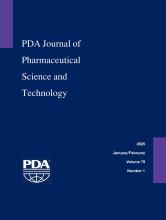Abstract
Patients can be exposed to leachables derived from pharmaceutical manufacturing systems, packages and /or medical devices during a clinical therapy. These leachables can adversely decrease the therapy′s effectiveness and/or adversely impact patient safety. Thus, extracts or drug products are chromatographically screened to discover, identify and quantify organic extractables or leachables. Although screening methods have achieved a high degree of technical and practical sophistication, they are not without issues in terms of accomplishing these three functions. In this Part 2 of our three-part series, errors of inexact identification and inaccurate quantitation are addressed. An error of inexact identification occurs when a screening method fails to produce an analyte response that can be used to secure the analyte′s identity. The error may be that the response contains insufficient information to interpret, in which case the analyte cannot be identified or that the interpretation of the response produces an incorrect identity. In either case, proper use of an internal extractables - leachables data database can decrease the frequency of encountering unidentifiable analytes and increase the confidence that identities that are secured are correct. Cases of identification errors are provided, illustrating the use of multi-dimensional analysis to increase confidence in procured identities. An error of inaccurate quantitation occurs when an analyte′s concentration is estimated by correlating the responses of the analyte and an internal standard and arises due to response differences between analytes and internal standards. The use of a database containing relative response factors or relative response functions to secure more accurate analyte quantities is discussed and demonstrated.
- Received December 8, 2018.
- Accepted June 17, 2019.
- Copyright © 2019, Parenteral Drug Association
PDA members receive access to all articles published in the current year and previous volume year. Institutional subscribers received access to all content. Log in below to receive access to this article if you are either of these.
If you are neither or you are a PDA member trying to access an article outside of your membership license, then you must purchase access to this article (below). If you do not have a username or password for JPST, you will be required to create an account prior to purchasing.
Full issue PDFs are for PDA members only.
Note to pda.org users
The PDA and PDA bookstore websites (www.pda.org and www.pda.org/bookstore) are separate websites from the PDA JPST website. When you first join PDA, your initial UserID and Password are sent to HighWirePress to create your PDA JPST account. Subsequent UserrID and Password changes required at the PDA websites will not pass on to PDA JPST and vice versa. If you forget your PDA JPST UserID and/or Password, you can request help to retrieve UserID and reset Password below.






